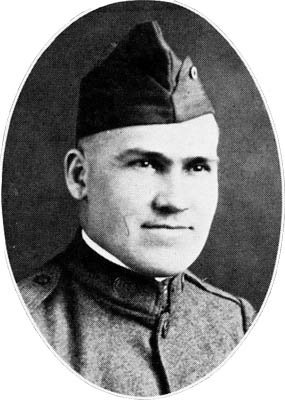 |
| | SERGT. LESLIE W. REDDAWAY
Serial No. 2,026,600
Kingston, Mich
Inducted September 29, 1917.
Reddaway took admirably to soldiering and was promoted to Corporal on November 11, 1917. Later, owing to his being a sign-painter in civilian life, he was promoted to Sergeant, along with Griffith, Brandt and Schultz, on December 8, 1917.
Thien Sergt. Kelley was sent to School of Fire, November 14, 1917. Reddaway was Acting 1st Sergeant. On Sergt. Kelley’s return, Reddaway was sent to the School of Fire.
On May 2nd, while on a hike, he received an injury to his knee which almost prevented his going overseas. He was confined to base hospital for five weeks but returned to the Battery with a weakened knee. He succeeded Sergt. Allen as Mess Sergeant, which duties he performed until we reached Camp Coetquidan. He, along with Private Stanton, was sent to School for Camouflage Instruction.
Camouflage is one of the new products of the war, even in the name, used for the first time by Gen. de Castelnau, Chief of Staff of General Joffre. The word is not good French, but comes from the argot, or French slang, the verb “camouflier” being used by French police to indicate any disguise used to capture criminals. The American army had on its staff many of the well-known mural artists, decorators and sculptors of America.
Reddaway frequently had to act as Sergeant-of-the-Guard. The boys will remember an amusing incident which occurred when, in the absence of Sergt. Major Vogel, Lieut. Gildart made him Acting Sergeant Major. Though Reddaway did not know all of the commands which a Sergeant Major should give, he took command and nearly walked the Guard over the band. By experimenting on commands he finally got them back into proper formation.
Reddaway was detailed Camouflage Sergeant of the First Battalion. In our approach to the front lines he had to accompany the reconnaissance p a r t y in order to determine how the terrain must be camouflaged.
During this period he was the hardest worked Sergeant in the Battery, as we were rapidly covering considerable territory. Aside from the arduous nature of his tasks he was constantly exposed to snipers and the common dangers of the lines. He was called upon to almost entirely forego rest and had to subsist on but little nourishment.
On one occasion the officers ordered that they speed up the camouflage of materiel, commanding that trees be cut down for that purpose in a nearby wood. Since the lens of the enemy airplane observers, who took pictures daily of the terrain back of our lines, would show the slightest change indicating troop movements, this could not be permitted according to his instructions in the science of camouflage. After some argument with them, Reddaway convinced them that other means could be used aside from and safer than cutting down trees.
At Pont-a-Mousson Sergt. Reddaway was detailed on special duty as Sergeant of Provost Guard, which duties he performed until the Military Police took charge.
Page eighty-six
Sergt. Reddaway particularly enjoyed the association of 2nd Lieut. Howard D. Sutliff, Corporals of the Guard Charles Sutherland and Carl C. Zink, and Detective of Guard Albert Bowie.
Having natural ability for pen sketch work, Reddaway was put on special duty as Battery Artist for the Regimental Book.
He was an indefatigable worker, conscientious, fearless of danger, and his guardian angel seemed to always secure for him some light and congenial detail.
The welfare of other human beings was an ingrained part of Reddaway’s nature, which made him considerate and kind in his association with his comrades.
He has used his gift for drawing to perpetuate the memory of incidents in our army life, which are a part of the records of the Battery in the war. |